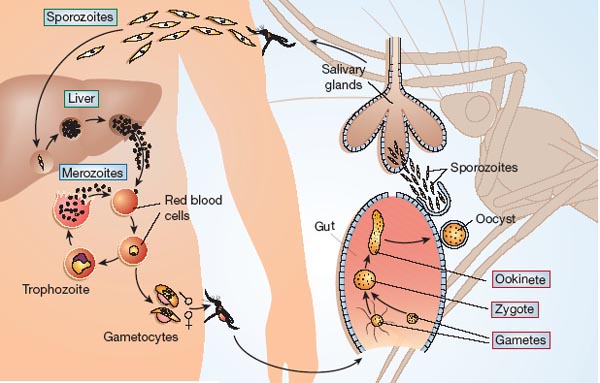The name
Malaria = mal' + aria = "bad air"
The name of the disease comes from a belief of the past that poisonous fumes over marshes shifted towards residential areas and made people sick. The truth is that these marshes were the breeding sites of the responsible for malaria transmission mosquitoes.
The disease
Malaria is an infectious disease caused by the malaria parasite (Plasmodium) and transmitted by female mosquitoes of the genus Anopheles.
The transmission routes
Main transmission route:
- bite by an infected female mosquito of the genus Anopheles, which previously had stung a person infected with malaria
Less common ways of transmission:
- blood transfusion
- transplantation
- infected needles
- from mother to fetus during pregnancy
IT IS NOT TRANSMITTED FROM HUMAN TO HUMAN
Transmission and parasite life cycle
Mosquitoes are considered "vegetarian" species as they feed on nectar and fruit juices. During pregnancy, though, they seek human blood cause they need to use its nutrients for the growth of their eggs.
When a malaria infected mosquito bites a healthy person, the parasites enter his/her blood circulation in the form of sporozoites, that in a few minutes manage to reach liver and enter its cells (Figure 1). There, they proliferate forming schizonts that will give birth to merozoites; merozoites are then released in the blood circulation where they invade the red blood cells. In there, they develop and multiply and then rupture the red blood cells causing symptoms to the infected human.
Some of the infected red blood cells, though, do not follow this path but differentiate in gametocytes (Figure 1), a parasite form that stays in the human blood -without causing any disease- and can be taken by a mosquito during a future blood meal. In the mosquito body, gametocytes evolve in sporozoites and in this way a parasite life cycle is completed; a new one is about to begin when this infected mosquito bites a human and transmits the malaria parasite.
 Figure 1. Plasmodium life cycle and transmission
Figure 1. Plasmodium life cycle and transmission
(Source: nature.com)